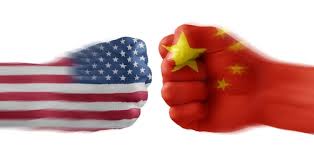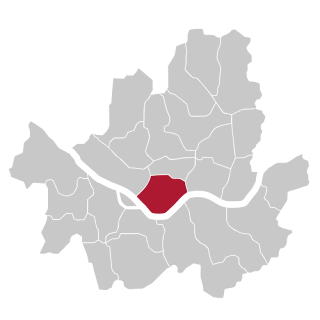Today's Asia Pacific: Asia Pacific Rebalance Strategy, THAAD and Arm Race in Asia Pacific
Figure 1: Sino-American Conflict in Asia Pacific
Eisenhower's speech of Military Industry of the United States:
Today Cold War is over but the militarization and tension remain in Asia Pacific. The end of Cold War indeed slowed down the militarization of United States in Asia Pacific but it was quickly followed by the backlash of "Asia Pacific Rebalance Strategy" by Obama's government.
"Asia Pacific Rebalance Strategy"[1], on the official website of U.S. Department of Defense, is described as
"Defense leaders remain focused on efforts to strengthen relationships and modernize U.S. alliances in the Asia-Pacific region as a priority for 21st-century security interests and sustaining U.S. global leadership."[2]
It sounds that the United States keeps its leadership by providing security to its allies in Asia Pacific and therefore it's win-win policy for the United States and its allies in Asia Pacific. However, the security provided by the United States is not free: it's both economically and politically expensive.
THAAD project in Korea is one of the latest steps of the U.S. military deployment in Asia Pacific. It aims at detecting and defending missiles from North Korea. [3] THAAD means Terminal High Altitude Area Defense, it is one the most advanced anti-missile system produced by Lockheed Martin Co. and costs more than 1 billion dollars not including extra cost for the land and associated facilities and President Trump asked Korea to pay for it.
Politically, South Korea paid heavily for THAAD system even before the deployment of THAAD. The relationship between China and South Korea is now questioned by the deployment of THAAD China urges South Korea to immediately halt the launch of THAAD system and proposed unofficial sanctions on South Korean Pop music singers, South Korean TV series and South Korean tourism. Lotte is the company who agrees to provide its land in Seongju and it was protested against by Chinese citizens. As a result, 80% of Lotte Markets are now forced to close in China. [4]
Figure 2 and 3: Protest against lotte market in China
Figure 3: Chinese protestors in front of South Korean consulate
THAAD deployment is also questioned by South Korean people. Voice against THAAD in Korea also condemns Lotte for providing land for the launch of THAAD system. (Figure 4) Newly elected South Korean president Moon Jae-In said South Korea needs to reconsider the deployment of THAAD system and it was also protested by many Koreans. [5]
Figure 4: Protest of THAAD by Korean people
Why both Korean and Chinese protest the deployment of THAAD? THAAD is not deployed in China but it has a lot to do with the containment of Chinese influence in Asia Pacific. Asia Pacific Rebalance Strategy turns out to be a policy not only about US allies but also about China. In fact, China takes a central role in the foreign policies of United States made upon Asia Pacific and Sino-American relationship becomes the most important play on the stage of Asia Pacific.
With rapid economic development comes the skyrocketing militarization of China and ambition in Asia Pacific. (Figure 5) United States consider China as a challenger of the status quo in Asia Pacific and hence proclaimed "Asia-Pacific Rebalance Strategy". In fact, the word "Rebalance" is a euphemism for tension and militarization. The ambition of China and the rebalance strategy of United States eventually trigger the backlash of arm race in Asia Pacific.
This project, "Domination of Asia Pacific", does not aim to blame or offend any country, neither United States, nor China, nor Indonesia or Japan. In the contrast, the aim of this project is let us rethink about our hegemony: should their really be a dominator in Asia Pacific?
[1]: Michael J.Green, “Asia-Pacific Rebalance 2025”, csis.org, CSIS,Web, January 19,2016
May 31,May 31,2017
[2]: U.S.Department of Defence, “ASIA-PACIFIC REBALANCE”, defense.gov, U.S.Department of Defence, Web, May 31,2017
[3]:Gerry Mullany, “U.S Starts Deploying THAAD Antimissile system in South Korea, After North’s tests”, nytimes.com, The New York Times, Web, March 6,2017, May 31 2017.
[4]:Javier C.Hernandez, “South Korean Stores Feel China’s Wrath as U.S. Missile System Is Deployed”, nytimes.com, The New York Times, Web, March 9,2017, May 31 2017.
[5]: Joseph Hincks, “South Korean Protest U.S.Missile Installation as Tensions Escalate on the Peninsula”, time.com,TIME,Web, Apr 28,2017, May 31 2017.
Eisenhower's speech of Military Industry of the United States:
Today Cold War is over but the militarization and tension remain in Asia Pacific. The end of Cold War indeed slowed down the militarization of United States in Asia Pacific but it was quickly followed by the backlash of "Asia Pacific Rebalance Strategy" by Obama's government.
"Asia Pacific Rebalance Strategy"[1], on the official website of U.S. Department of Defense, is described as
"Defense leaders remain focused on efforts to strengthen relationships and modernize U.S. alliances in the Asia-Pacific region as a priority for 21st-century security interests and sustaining U.S. global leadership."[2]
It sounds that the United States keeps its leadership by providing security to its allies in Asia Pacific and therefore it's win-win policy for the United States and its allies in Asia Pacific. However, the security provided by the United States is not free: it's both economically and politically expensive.
THAAD project in Korea is one of the latest steps of the U.S. military deployment in Asia Pacific. It aims at detecting and defending missiles from North Korea. [3] THAAD means Terminal High Altitude Area Defense, it is one the most advanced anti-missile system produced by Lockheed Martin Co. and costs more than 1 billion dollars not including extra cost for the land and associated facilities and President Trump asked Korea to pay for it.
Politically, South Korea paid heavily for THAAD system even before the deployment of THAAD. The relationship between China and South Korea is now questioned by the deployment of THAAD China urges South Korea to immediately halt the launch of THAAD system and proposed unofficial sanctions on South Korean Pop music singers, South Korean TV series and South Korean tourism. Lotte is the company who agrees to provide its land in Seongju and it was protested against by Chinese citizens. As a result, 80% of Lotte Markets are now forced to close in China. [4]
Figure 2 and 3: Protest against lotte market in China
Figure 3: Chinese protestors in front of South Korean consulate
THAAD deployment is also questioned by South Korean people. Voice against THAAD in Korea also condemns Lotte for providing land for the launch of THAAD system. (Figure 4) Newly elected South Korean president Moon Jae-In said South Korea needs to reconsider the deployment of THAAD system and it was also protested by many Koreans. [5]
Figure 4: Protest of THAAD by Korean people
Why both Korean and Chinese protest the deployment of THAAD? THAAD is not deployed in China but it has a lot to do with the containment of Chinese influence in Asia Pacific. Asia Pacific Rebalance Strategy turns out to be a policy not only about US allies but also about China. In fact, China takes a central role in the foreign policies of United States made upon Asia Pacific and Sino-American relationship becomes the most important play on the stage of Asia Pacific.
With rapid economic development comes the skyrocketing militarization of China and ambition in Asia Pacific. (Figure 5) United States consider China as a challenger of the status quo in Asia Pacific and hence proclaimed "Asia-Pacific Rebalance Strategy". In fact, the word "Rebalance" is a euphemism for tension and militarization. The ambition of China and the rebalance strategy of United States eventually trigger the backlash of arm race in Asia Pacific.
This project, "Domination of Asia Pacific", does not aim to blame or offend any country, neither United States, nor China, nor Indonesia or Japan. In the contrast, the aim of this project is let us rethink about our hegemony: should their really be a dominator in Asia Pacific?
Works Cited
[1]: Michael J.Green, “Asia-Pacific Rebalance 2025”, csis.org, CSIS,Web, January 19,2016
May 31,May 31,2017
[2]: U.S.Department of Defence, “ASIA-PACIFIC REBALANCE”, defense.gov, U.S.Department of Defence, Web, May 31,2017
[3]:Gerry Mullany, “U.S Starts Deploying THAAD Antimissile system in South Korea, After North’s tests”, nytimes.com, The New York Times, Web, March 6,2017, May 31 2017.
[4]:Javier C.Hernandez, “South Korean Stores Feel China’s Wrath as U.S. Missile System Is Deployed”, nytimes.com, The New York Times, Web, March 9,2017, May 31 2017.
[5]: Joseph Hincks, “South Korean Protest U.S.Missile Installation as Tensions Escalate on the Peninsula”, time.com,TIME,Web, Apr 28,2017, May 31 2017.






Comments
Post a Comment